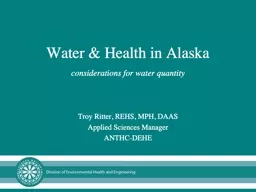

considerations for water quantity Troy Ritter REHS MPH DAAS Applied Sciences Manager ANTHCDEHE Documented health benefits of improved water service in Alaska Acute respiratory infections ID: 909198
Download Presentation The PPT/PDF document "Water & Health in Alaska" is the property of its rightful owner. Permission is granted to download and print the materials on this web site for personal, non-commercial use only, and to display it on your personal computer provided you do not modify the materials and that you retain all copyright notices contained in the materials. By downloading content from our website, you accept the terms of this agreement.
Slide1
Water & Health in Alaskaconsiderations for water quantity
Troy Ritter, REHS, MPH, DAAS
Applied Sciences Manager
ANTHC-DEHE
Slide2Documented health benefits of improved water service in Alaska
Acute respiratory infections
Skin infections
Invasive pneumococcal disease
Slide3Bradley Classifications
Waterborne diseases:
where the pathogen is in the water and causes illness when ingested
Water-washed diseases:
where transmission of the pathogen is interrupted by washing with water
Slide4Slide5How much water is needed for optimal health?
Slide6Water Quantity Guidelines
With internal fixtures
The World Health Organization
4
:
26.4
Cold Regions Utilities Monograph
5
:
15.9No internal fixturesGleick3: 13.2The World Health Organization8: 13.2The Sphere Project6: 4The UN Refugee Agency7: 4-5
*All units are gallons/person/day
Slide7How much water is needed
for optimal health (in Alaska)?
Slide8Impact of piped water on rates of infections
Start with 4 villages with only self haul water
Collected data on water use and health
Most households were proved piped services
Collect data on water use and health after pipes
Slide9Opportunities for Observation
Water use in self-haul households
Water use in piped households
Water use in transition from self-haul to piped
Slide10Water use in self-haul households
Residential water use < 2 gpcpd
Slide11Mean Water Use
Predicted Water Use
Self-haul Water Use
Self-haul Water Use
Change in Household Water Use (volume)
Slide12Self-haul use
Change in Soap Use (volume)
Slide13Change in Water & Soap Use (volume)
Slide14"When our kids come in dirty we just put them in the bath. It's really easy we don't have to heat water for the bath.“
“You can take shower anytime.“
"With the potable water, you can wash your hands more frequently."
"We don't have to wash hands in the same water.“
"Cleaner kids. Cleaner house. Our family doesn't get sick that often.“
"People have readily available water to wash hands and dishes."
“You can wash your hands. You have water all the time. Dishes are done whenever they need to be.
"Has been nice to be able to wash everyday"
Comments about water use…
Slide15Change in (piped) Water Use by Village
Village A
Village B
Village C
Village D
Self-haul Water Use
Slide16What about small vehicle haul systems?
Slide17Water use in small-haul households
Residential water use < 2 gpcpd
Water use in self-haul households
Self-haul vs. Small haul
Residential water use < 2 gpcpd
Slide18Promoting healthy water use through education
Slide19“You can teach a dog to swim but you can’t teach a dog to snorkel”
- Calie Ritter, age 6
Slide20Recommendations for optimal health
There’s no “magic number”. Water use needs are specific to the system and population.
Optimal health is achieved through an integrated approach that includes provision of infrastructure, proper O&M and education to encourage healthy water use behaviors.
Water service must be affordable in order to provide a health benefit. User fees should be independent of water use.
Slide21References
Brundin, I., & Hennessey, T. (2011). Literature review of water quantity standard for optimal health in arctic regions.
Eichelberger
, L. P. (2010). Living in utility scarcity: energy and water insecurity in northwest Alaska
. Am Journal of Public Health, 100
(6):1010-18. 3. 4. 5.
Gleick
, P. (1996). Basic water requirements for human activities: Meeting basic needs.
Water International, 21
:83-92.Howard, G. & Bartram, J. (2003). Domestic Water Quantity, Service Level and Health, World Health Organization. Retrieved January 20, 2012 from http://www.who.int/water_sanitation_health/diseases/WSH03.02.pdf Smith, D.W. (Ed.). (1996). Cold Regions Utilities Monograph, (3ed Ed.). New York, NY: American Society of Civil Engineers.
The Sphere Project. (2011). Minimum standards in water supply, sanitation and hygiene promotion. In
The Sphere Project Handbook
, (pp 79-137). Rugby, UK:
Practical Action Publishing. Retrieved January 18, 2012 from http://www.your-brochure-online.co.uk/sphere_handbook_english_2011/html/
UNHCR
. (1992).
Water Manual for Refugee Situations.
Retrieved January 18, 2011 from http://www.unhcr.org/3ae6bd100.html
World Health Organization. (2010). Minimum water quantity needed
for domestic use in emergencies.
Retrieved January 18, 2012 http://www.who.int/water_sanitation_health/hygiene/envsan/minimumquantity.pdf
Slide22Drinking
Cooking
Personal Washing
Washing Clothes
Cleaning Home
Waste Disposal
Non-Residential
Hierarchy of Water Requirements
(after Maslow’s hierarchy of needs)
Increasing
Quantity
“Zone of Water-Washed Infection”